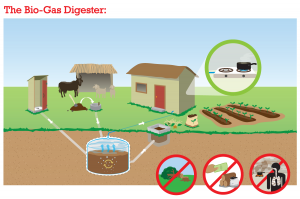Bio-gas is one such energy which is environmentally clean, renewable and also an extremely Eco-friendly fuel. The main content of bio gas is methane. It is produced in the process of breaking down of food wastes, manure, crops of agriculture by the micro organisms present in waste water treatment plants. The greenhouse gases being not released in the production of energy in this process has made it a popular renewable source. The agriculture livestock sectors prefer bio gas as it can be easily produced by considering the anaerobic digestion of animal wastes. The energy content of bio gas can be improved by upgrading the raw bio gas.
How is bio gas produced?
The bio gas plants have anaerobic digesters which trap the bio gas inside. The anaerobic digestion is also termed as fermentation which is the basic process wherein the organic materials are degraded using the micro organisms. These anaerobic digesters are tanks that store the animal and other household wastes. There is a vacuum pump that is also provided to it which sucks in the bio-gas with the help of a blower or a gas pump. This bio-gas can be used to produce energy that is necessary in providing energy for domestic purposes or otherwise can be given to the electrical grid too. This bio-gas contains about 60% to 80% of only methane which can also operate space heater or chiller that is also made available inside the equipment. Also, the gas that is left unused or wastes is ignited such that the methane odor or emissions are reduced.
The history:
It is said that the first use of methane as a source of power was done in India at a leper colony. Though organic matter was decomposed before in many other places to produce a gas that was flammable, the original modern use of methane as an energy source was done in India in the year 1859. It was England who followed this and started producing bio-gas in 1885. There were power gas streetlamps that used to operate only on the energy produce by bio-gas.
Even today, bio-gas use is encouraged since it is renewable, a green source and exceptionally Eco-friendly as well.
Using manure to produce bio-gas:
A plethora of organic waste products are aerobically digested in an air-tight container that is also oxygen-free and thus produces bio-gas.
The process:
Initially, the anaerobic bacteria help in breaking down of the organic matter to produce an organic liquid. This liquid is then digested by the methane forming bacteria to produce a liquid that is nutrient-rich and also has low odor. These gas products are then tapped to produce the bio-gas which are then used a fertilizer too.
It is also estimated that the manure of 3 cattle can produce enough energy to run a refrigerator for a day. Also, a herd of 72 animals can also provide enough heat to a medium sized home as well.
Thus manure when used in a right manner also is used as a very good substitute for the conventional burning of fossil fuels.
The advantages of bio-gas:
Being renewable, Eco-friendly and an environmentally clean fuel, bio-gas is itself a very advantageous fuel for the modern day. It also helps in the considerable reduction of the usage of conventional fuels and this serves as a boon in the renewable energy industry. Bio-gas is in fact a carbon neutral because the carbon is released into the atmosphere in sync with the rate at which it is absorbed in the process of photosynthesis. Hence, it doesn’t impact on the environment and is apparently a carbon neutral. Bio-gas helps in the reduction of the greenhouse gases as well. Since it converts the methane into carbon dioxide, the global warming effects are considerably reduced.
Bio-gas has one more very important use and that is the reduction in the organic wastes in the environment. Thought we can consider the use of bio-gas in the perspective of the conservation of non-renewable source, it also helps in clearing the excess sewage and animals waste that lie around .Moreover, this bio-gas can also be used a fertilizer by treating the low-odor digestate for the necessary contaminates.
Bio-gas helps in reducing landfill and thus helps in reducing the water and soil pollution. Moreover, bio-gas uses a very cheap technology and there are no much expenses that are incurred in setting up a bio-gas plant. The compressed natural gas (CNG) is in fact bio-gas that is in its compressed form and can be used for a number of purposes like as vehicle fuel. Small or larger plants, as per requirement, can be setup for the production of biogas.

Bio-gas has also created numerous jobs and provides employment to the people in rural areas as well. It can also be setup and used in areas where there are frequent power outages. Besides, these plants when setup require very little capital investment and can also be set up in a small scale basis for an individual home too.
The advantages of bio-gas are plenty and its use must be encouraged so that the use of non-renewable energy is considerably minimized. Bio-gas is indeed an excellent substitute for the exhausting fossil fuel energy.





Leave a Reply